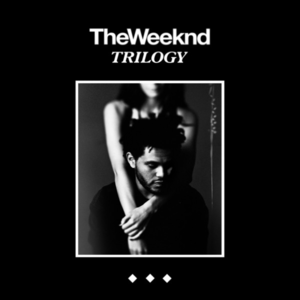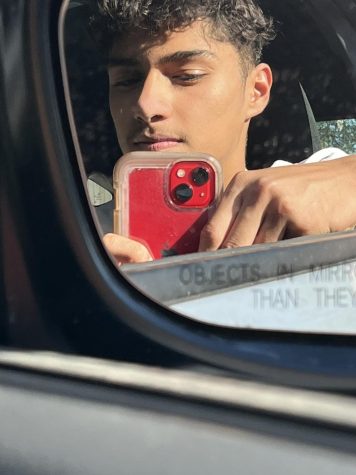The Weeknd’s Trilogy

May 19, 2023
DISCLAIMER: The following review includes subject matter that describes dangerous and obscene situations. The Riverhawk Review and CRHS does not condone behaviors described in the artist’s material. The album comes with a parental advisory for explicit content.
During the early 2010’s, many well known names of today started their come-up, such as Drake, Nicki Minaj, Beyonce, and Frank Ocean. These celebrities have gone on to make their place in the music industry. However, none had such a sudden and strong, yet dark start like Abel Tesfaye, better known as “The Weeknd”.
When The Weeknd was first starting off, he was collaborating with artists all over the Toronto area with getting his name out there being his first priority. Then when he met Jeremy Rose, they created three songs that would take him to the next level. With Abel receiving praise from Drake for his singles, he took that as the green light to drop his first album/mixtape, House of Balloons.
House of Balloons came out of nowhere, partly due to Abel not advertising the album at all. The murky and eerie tone of the album set it apart from the other projects being released at the time, and gave it the spotlight. The project is based on a man similar to Abel, most commonly referred to as The Weeknd. And while Trilogy is a fictional story, a lot of it is derived from Abel’s life and situations he has gone through.
The album depicts Abel’s life as it was: drugs and sex. Abel would frequently lead women on, manipulating them into thinking he cared for them, either until they found him with other women and left, or until they became names in his contact list, being nothing more than another person to sleep with when bored.
The Weeknd would frequently throw parties at his house, inviting women to throw their life to the drugs and alcohol he would often force onto them, as described in the song, “House of Balloons/Glass Table Girls”. However, in the chorus of that song, Abel is shown trying to convince others that they’re having fun and not to leave him; mostly because he is scared of being alone. This fear of loneliness drives Abel to manipulate the people around him, to extract as much happiness from them as he can. When they end up leaving him, he moves on to the next. This cycle of destruction has become the norm for Abel, and he has no plans to change.
The second mixtape in the trilogy dropped only five months after House of Balloons, called Thursday. Thursday is shown through the eyes of one of Abel’s girls, Valerie. Valerie has fallen in love with Abel, but the love is only one-sided. Abel has six other women that he is with and only sees Valerie on Thursday. In fact, Valerie is so irrelevant to The Weeknd that he thinks about other women when he and her are together, as stated in “The Zone.” The Weeknd explains to Valerie that he is a bird; he’ll leave her for someone better like a bird migrating for summer. So when he inevitably does that, she can’t handle it. Valerie ends up taking her own life.
While The Weeknd put up the front that he didn’t care that she was gone, Valerie’s death later revealed that he actually cared deeply for her. Saying how he would hesitate touching other women. Abel says how if Valerie would have stuck around, she would’ve had him wrapped around her finger, “You probably could have had it all, you could have been that lonely star.” Abel never got the chance to tell Valerie that he loved her. Whether that’s because he was scared of putting himself out there or not is still a mystery. Abel must now move on from her death without letting others in on his lost love, bearing the load by himself.
Echoes of Silence was the third and final part of The Trilogy, with the first two mixtapes bringing him into celebrity status. He no longer needs to manipulate women as they are now throwing themselves at him knowing what will happen. The Weeknd shows us a brief glimpse into his psyche with “Montreal”, telling us how he doesnt know how to handle his new found fame and how he isn’t as emotionless as he makes himself to be. He warns himself that if he continues down this road, one day he will be the one left behind, yet he doesn’t listen.
The Weeknd meets up with a woman that once left him when he was first coming up. He coaxed her into his lifestyle of drugs and sex once again, and she takes the bait. They become mirror images of one another. He brings her to one of his XO parties to get her cross-faded. Once she gets drunk, Abel finally gets revenge on her for leaving him, for sending Abel to his deeply rooted fears. Abel and his “boys” all took advantage of the girl, with her clearly wanting it to stop. Abel then drops her just like that, like another one of his girls, just because she bored him.
The last songs of the album show The Weeknd finally going through what he put others through, he is hurt by the women he chases and when he asks why, she replies with, “I like the thrill, nothings gon’ make me feel this real,” sounding exactly like something The Weeknd would tell one of his girls. Even in “Till Dawn” he is depicted as the side piece, only receiving love from her when she isn’t busy with her boyfriend. But he’s fine with it, filled with delusions that she’ll leave her boyfriend for him one day.
The Trilogy album is Abel’s story of fighting his loneliness by searching for “love”. The majority of the album is the consequences of Abel’s inability to find true love, with him replacing it with what he believes to be the closest thing to it that he can find. Even though what Abel did was disgusting at the very least, he did it out of a yearn for love and acceptance. So when listening to Trilogy, one must stop to think if The Weeknd is the villain he makes himself out to be, or if he is a misguided soul looking for man’s ultimate purpose.

